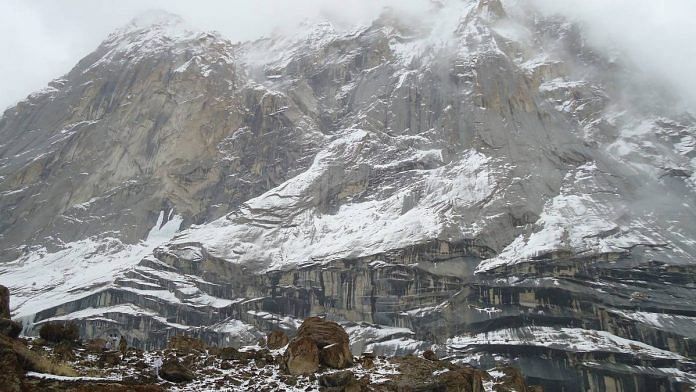New Delhi: It was on this day, 35 years ago, on a moonless night, 21,000 feet above sea level that Second Lieutenant Rajiv Pandey and 10 of his soldiers from the 8th Jammu and Kashmir Light Infantry (JAK LI) made the ultimate sacrifice at the Siachen glacier while trying to dislocate Pakistani troops from a crucial peak.
In April 1986, the Pakistan army established control over the highest peak at the Siachen glacier, south of the crucial pass at Bilafond La, and set up a military post there. The peak was re-named ‘Quaid Post’ by the Pakistan Army.
The captured post was at an advantageous height, giving the Pakistan Army leverage over Indian posts in Bilafond La.
A year later, in April 1987, Pakistani soldiers fired at Indian troops stationed at Sonam post, where the Indian forces set up the first helipad at Siachen, killing two.
To take back control of the Quaid Post and avenge the loss of the fallen soldiers, a party of 13 from the 8th JAK LI set off on a reconnaissance mission on the 29 May, 1987, to gauge the best route to launch a counteroffensive.
Also read: India vs Pakistan military lesson from Ukraine — generals must let leaders know defence reality
Ambiguity about Siachen till the 1980s
India and Pakistan’s fight over Siachen has been described by the eminent scholar of South Asian security, Stephen Cohen, as “two bald men fighting over a comb”.
Until the 1980s, there was ambiguity about who controlled the uninhabitable Siachen glacier, where temperatures drop to almost -50 degrees Celsius. The glacier lies in the high-Himalayas, northeast of point NJ9842, where the Line of Control (LoC) between India and Pakistan ends.
Neither the Karachi Agreement of 1949, nor the Simla Agreement of 1972 offered any clarity on the Siachen glacier. However, in the 1970s, interest in the glacier started to rise as India and Pakistan started sending mountaineering expeditions.
In 1984, India launched a preemptive strike, Operation Meghdoot, and took control over most of the Siachen glacier. Till today, India administers most of the Siachen glacier.
11 bravehearts of the 8th JAK LI
The recce mission led by 2nd Lieutenant Pandey involved the party traversing nearly 3 km on the edge of the glacier face and then managing the pitfalls of climbing a 1,500 ft ice wall with steep gradients that guarded the entry to the post.
The operational plan was to tie ropes and put crampons on the almost perpendicular wall to allow a larger follow-up force to climb up the ice wall and make an assault on the post.
The Pakistan Army had deployed the Shaheen Company of the three Special Services Groups to guard the post. Subedar Atauallah Mohammed commanded the company with a deployment of around 15-20 men.
As 2nd Lieutenant Pandey and his men were assiduously tying the knots on the wall, placing the crampons and pitons on the ice wall, and fixing the rope through them to enable a swift climb for the counterforce, they were overheard by the Pakistani guardsmen of the Shaheen Company. Since the Indian troops had ascended several feet up the ice wall, the Pakistani guardsmen, barely a few hundred feet above them, had spotted them.
Consequently, a machine-gun assault was launched by the Pakistanis on the Indian soldiers and 11 of the Indian soldiers died in the cross-fire, including 2nd Lieutenant Pandey.
The other 10 from the 8th JAK LI who gave their lives that day were Naib Subedar Hem Raj Sharma, Havildar Mulkhraj, Havildar Avtar Singh, Naik Kuldeep Singh, Rifleman Ved Parkash, Rifleman Daleep Kumar, Rifleman Girdhari Lal, Rifleman Sham Lal, Rifleman Shiv Ram and Rifleman Kashmiri Lal.
2nd Lieutenant Pandey was honoured with the gallantry award posthumously, the “Vir Chakra” for his exceptional gallantry, determination and supreme sacrifice.
Also read: Military has no Martyrs: Army to honour fallen soldiers with 11 new salutations
Operation Rajiv & Bana Top
The survivors from the JAK LI party were able to relay the information to their unit that the ropes had been laid along with crampons and pitons for the counterforce to climb up the ice wall and take over the post.
Consequently, in June 1987, a party of 64 of the JAK LI, commanded by Major Varinder Singh, launched a counter-offensive to take the tactical post back from the Pakistan Army.
The operation was code-named ‘Operation Rajiv’ in honour of Second Lieutenant Rajiv Pandey. The ropes and footholds masterfully laid by him and his men were found buried underneath the snow by the party.
This ensured that Varinder Singh and his men could navigate themselves over the wall. After intense artillery cross-fire for two nights on 25 and 26 June, the Indian troops, under Major Singh’s command, took back ‘Quaid Post’.
To honour the service of the personnel who ensured this victory, the army awarded a Param Vir Chakra to Naib Subedar Bana Singh, one of the assault parties, and renamed the Quaid Post ‘Bana Top’.
Major Varinder Singh was awarded a Vir Chakra for his bravery.
(Edited by Zinnia Ray Chaudhuri)
Also read: The winner as underdog






